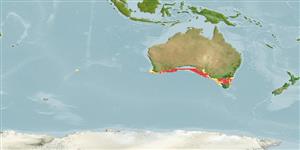Élasmobranches (requins et raies) (sharks and rays) >
Carcharhiniformes (Ground sharks) >
Pentanchidae (Deepwater catsharks)
Etymology: Asymbolus: Etymology not explained, possibly a-, Latin privative, i.e., without; sym-, from syn (Gr.), together or joined; bolus (L.), lump or morsel, proposed as a subgenus of Scyliorhinus (Scyliorhinidae) distinguished in part by labial fold of upper lip not hanging over lower-jaw symphysis of A. analis and A. vincenti (See ETYFish); vincenti: Etymology not explained, probably named for Gulf St Vincent, where Kangaroo Island (southern coast of Australia), type locality, is situated (See ETYFish).
Eponymy: These species and genus are named after the location where the holotypes were caught – the Gulf of St Vincent, near Kangaroo Island, South Australia. (Ref. 128868), visit book page.
Environment: milieu / climate zone / depth range / distribution range
Écologie
marin récifal; profondeur 27 - 650 m (Ref. 75154). Temperate; 33°S - 42°S
Eastern Indian Ocean: Australia.
Taille / Poids / Âge
Maturity: Lm ? range ? - ? cm
Max length : 61.0 cm TL mâle / non sexé; (Ref. 244)
Widespread on the continental shelf and slope edge (Ref. 244). Oviparous, with a single egg-case to each oviduct at a time (Ref. 244).
Life cycle and mating behavior
Maturité | Reproduction | Frai | Œufs | Fécondité | Larves
Oviparous, paired eggs are laid. Embryos feed solely on yolk (Ref. 50449).
Last, P.R. and J.D. Stevens, 1994. Sharks and rays of Australia. CSIRO, Australia. 513 p. (Ref. 6871)
Statut dans la liste rouge de l'IUCN (Ref. 130435: Version 2024-2)
Utilisations par l'homme
Pêcheries: sans intérêt
Outils
Articles particuliers
Télécharger en XML
Sources Internet
Estimates based on models
Preferred temperature (Ref.
123201): 11.8 - 15.8, mean 14.2 °C (based on 22 cells).
Phylogenetic diversity index (Ref.
82804): PD
50 = 0.5020 [Uniqueness, from 0.5 = low to 2.0 = high].
Bayesian length-weight: a=0.00355 (0.00175 - 0.00721), b=3.08 (2.90 - 3.26), in cm total length, based on LWR estimates for this (Sub)family-body shape (Ref.
93245).
Niveau trophique (Ref.
69278): 4.5 ±0.80 se; based on food items.
Résilience (Ref.
120179): Faible, temps minimum de doublement de population : 4,5 à 14 années (Fec assumed to be <100).
Fishing Vulnerability (Ref.
59153): Moderate vulnerability (44 of 100).
